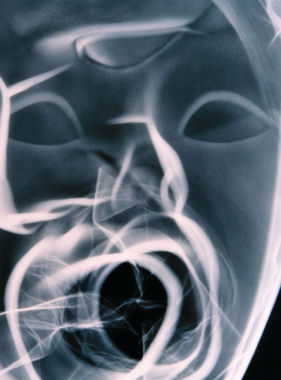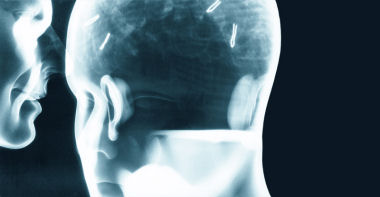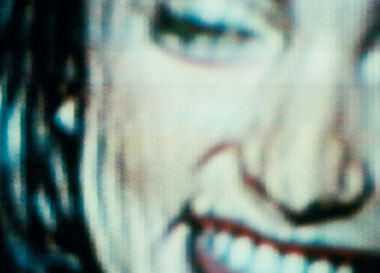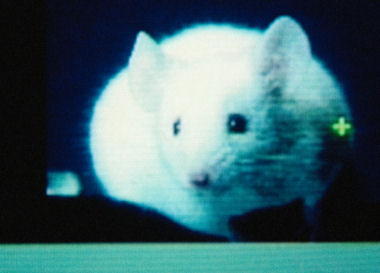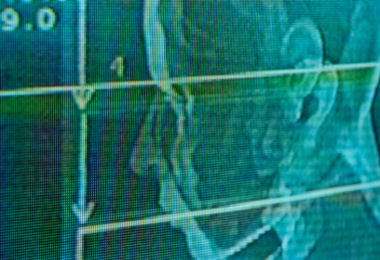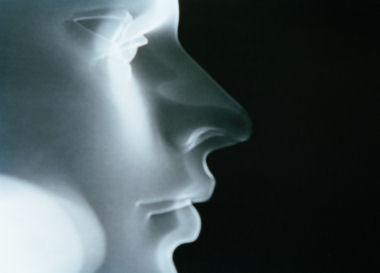This article investigates the use of imaging-generating techniques in contemporary art practices through the examination of Gabriele Leidloff’s art production. It places the artist’s work within the tradition of Muybridge and Marey’s scientific-artistic experiments. Focusing on Leidloff’s peculiar use of imaging-generating technologies, the article explores the emergence of a haptic vision which opens up into the techno-vision of scientific technologies.
As with a lot of other contemporary encounters, I first came across the work of the German artist Gabriele Leidloff online. Her forum log-in/locked out [1] produces artistic installations related to cultural and economic events in collaboration with international partners in different countries. The goal is to engage neuroscientists, artists, image theoreticians, filmmakers, and entrepreneurs in a challenging dialogue. These are particularly characterized by a fascination with the construction of mental images by means of cutting-edge imaging technologies.
The concrete encounter between artists and scientists, however, arises, is nurtured and is consumed in the laboratory in the course of progressing through experiments and using the same instruments. Nowadays this relationship is commonly understood either as the capacity of scientists to render their achievements in images or as the attempts of artists to translate scientific findings into aesthetically valuable pictures or artifacts.
Leidloff’s log-in/locked out, on the contrary, seems to propose playful experiments focused on the exploration of instruments themselves rather than being limited to the production of a finished work of art. Her peculiar use of medical imaging devices exposes and reflects the vision promoted by the instruments themselves, opening up new forms of visuality in opposition to clinical ones. Imaging-generating technologies become the material sites where a techno-vision emerges. These instruments present us with unknown worlds in a similar way to what happened previously in the history of optical devices, from the camera obscura through the microscope, chronophotography, the invention of X-ray and the current medical technologies like magnetic resonance imaging. [2]
Intrigued, I sought a direct encounter with Leidloff’s work by visiting her personal exhibition at the Wissenschaftskolleg zu Berlin [3] last April. As I entered the hall I was confronted with the unfamiliar face of Goethe’s X-rayed plaster life mask. Goethe (1996) incarnates the leitmotiv of the exhibition: a scientist-artist alliance as testimony to Goethe’s interest in the mechanism of vision, his studies in optics in particular, and poetry. It is worth noting that masks were commonly used at that time, along with drawings and portraits, as photography was yet to be invented. The contrast between the density of the image and the artificial coldness of the light box that frames and displays the mask generated an uncanny feeling in me. It was as if I was in a hospital watching radiographs of patients rather than attending an art exhibition. The rather vague features of Goethe allowed me to build up in my mind how the living Goethe would have looked, given the fact that we do not have any portraits or drawings of him. Leidloff’s X-rayed mask seemed to bring to the surface the personality of Goethe and, departing from that, to allow me to create the physical lineaments of Goethe’s face. The inside becomes the outside. This turn runs counter to the usual way we operate, namely by starting from certain physical appearances to deduce the character of a person.
Ghostly Goethe escorted me to the next radiograph entitled John and Girl (2005): this time not a famous figure from German history but two unknown people frozen maybe in the act of shouting or in the instant of emitting their last breath. As with Goethe, Leidloff’s use of X-ray negates the main property of Roentgen’s discovery: the possibility to penetrate a body, rendering it transparent to our investigative gaze. At first sight the impulse behind Leidloff’s work seems to be analogous to that of many scientists using medical imaging technologies: the documentary impulse to make visible what cannot be seen, what is not immediately to hand, to document the un-documentable. However, in contrast with the use of radiography in early physiological films, Leidloff’s images are not flat and graphically oriented but dense. Leidloff’s radiographs, printed using blue film [4], do not allow our gaze to easily go beyond the solid matter to reach the bones. Instead they force my sight to become “haptic" [5], that is, a combination of tactile, kinesthetic, and proprioceptive functions leading to a sense of touching the dense surface of the images.
This is how it works. The X-rayed plaster masks would normally appear to be black and white when hanging on the wall in light boxes. By taking soft X-rays and then photographing them in a double exposure, Leidloff provides them with a dense bluish appearance. In this way the images cease to be mere representational pictures and gain a quasi-living quality through depth and density. Similarly to Goethe’s mask, John and Girl let the inside become the outside: the plastic (the material that should have been available to the penetrating gaze of X-rays) emerges on the surface in all its thickness and impenetrability even after being X-rayed. Any further search for what lies beneath appears to be meaningless as there is nothing left to view. The outside is all we have, there is no hidden-forbidden inside to be investigated. Leidloff is well aware of the disembodied character of the images provided by imaging-generating technologies and mocks these technologies by creating images where the analytical, objective gaze coexists with an increasingly enigmatic glance.
The first impression I have watching the digital video installation In pursuit (2004) is a harmful sensation caused by the detailed focus of the video: cut off from the rest of the body and even from the other, complementary eye, the single eye of the artist opens and closes rhythmically while being tracked by an eye-tracking machine. There is a double circle of gazes in the installation In pursuit : the eye of the machine records the mechanical movement of the artist’s eye. At the same time, however, it is not the machine which investigates the eye, but rather the eye itself watches the viewing machine in the attempt of resisting and even opposing it. The eye ceases to be the transparent window to access the soul and becomes a material barrier to scientific investigations: the eye shuts down in order to avoid the violent act performed by the machine. The artist attempts to escape the tracking of her iris and the frame of the video projection in order to put into question the passive relationship with the eye-tracking device.
Leidloff’s images do not focus only on the eye; they also depict limbs and other parts of the body. A foot and a leg from below the knee made up the installation Bare foot meeting the floor and walking, a detail based on the sequence X-ray film-strip (2001). This sequence of single limbs detached from the rest of the body was presented in a filmic manner. Each single image was not self-contained and static but in constant movement and unresolved. Each footstep was only lightly sketched, not fully performed, always on the verge of collapsing while blending or dissolving into the next image. This tension created a narrative dimension that obliged me to link together the analytical images and look for a complete movement (maybe a dance step) and even for a story line.
Far from being mere diagnostic devices, medical imaging technologies in artists’ hands become storytellers. However, which story and whose story do they recount? The story of our perception, the story of the artist, of a particular patient? I started wondering who were the models for Leidloff’s images: long-limbed persons, maybe dancers? I was puzzled by the lack of any traces of what constitutes humanity, of what permits me to identify the subjects of the radiograph as human beings: i.e. the bones, the skeleton. The indexical character common both to photography and radiology is put into question, their authority to represent and unveil things as they are is undermined. Whilst in laboratory practice medical imaging technologies function as an indexical register of identity and difference, in Leidloff’s art they have an iconic character.
Leidloff plays ironically with the iconology of the Dance of Death: not a row of skeletons to remind us of our unavoidable mortality and, at the same time, of the decaying material substance we are made of, but sex dolls, mannequins and life and death masks, all rendered so highly sensual and carnal that they could almost be touched. The spectacle of death cohabits with the celebration of life and sensuality as it happened in the early days of radiography. The ‘memento mori’ in Leidloff’s images is curiously disguised through the affirmation of life by means of inanimate materials: maybe an intuitive glimpse into the future of our posthuman bodies?
While watching Leidloff’s sequences or single images we are constantly asked, as active spectators, to wander around, searching for what is not immediately apparent to our eyes, trying to reconstruct fragments in a meaningful story. Her images do not come to us already indexed but they are rather potential images [6] that free us from a single interpretation (or two interpretations, as in optical illusions) in order to keep us in an enigmatic space. I am reminded of Walter Benjamin’s image of a surgeon’s knife. For Benjamin, the camera operated surgically on the human body by seeing it in fragments and thus penetrating more deeply into its true existence and reality. Similarly, the imaging-generating techniques are Leidloff’s knife to explore bodily perception. The nature of seeing is subjective and active: the very principle of representation is transformed, and not only in terms of the object seen. In X-ray film-strip, for example, the notion of a privileged point of view, and along with it of a central perspective, is substituted by alternate perspectives and glances (that of the artist, of the spectator, of the subject depicted) that at times merge and at times diverge.
The ironic and postmodern character of Leidloff’s work comes from a constant negation of the original diagnostic intentionality inscribed in the instrument. The masks framed within medical light boxes and the easily recognizable medical devices are always invested with other possible and plausible connotations. This is where Leidloff’s practice diverges from that of the scientist: her self-reflexive use of medical imaging technologies reflects on the vision promoted by the instruments themselves, opening up another way of looking at ourselves and at the world. Leidloff is not interested in using scientific instruments to acknowledge their role in shaping science’s visualism. She is far more interested in exploring the dimension of the in-between: between science and art, visible and invisible, the inner and the outside, death and life. There is no final result to be displayed, no end to the story but a continuous mise-en-scène of a spectacle, perhaps inspired by Leidloff’s background as theatre director and performer. She started working with imaging-generating technologies when re-staging scenes from films in order to criticize the role of media.
Sex dolls, mannequins and ghost-like masks are displayed on the stage at the start of the play in one image of the series Ugly Casting presented in Berlin. Ugly casting 1.2. (2000) was obtained through the use of computer tomography, radiography, colour photography, video still and eye-movement recording. The series Ugly casting consists of fragmented sequences to be displayed one opposite the other as if they were in a dialogue. The sequences are respectively images of mannequins, images from a television presenter recorded using different camera angles and images obtained from masks of guillotined persons declared criminals by Nazis that Leidloff found in a museum in Hamburg. [7] Analytical close ups and framed sequences coexist with the fluid narrative dimension of the whole series. The image of the television presenter is captured usnig camera angles that differ from the television ones and focus on details of the presenter’s face, specially the mouth which opens and closes to articulate words. Two masks of dead criminals are placed one close to the other as if about to kiss. The spectator could build up her own story not only by following the succession of sequences but also by focusing her attention on each single close-up. Narration is present, therefore, both within every single sequence and within the whole series. Our familiarity with media images leads us to perceive the kiss represented in the third image as a classical, Hollywood-style romantic gesture without realizing that it is, on the contrary, an ironically staged homoerotic version of it. What appeared to be true at a first glance is revealed then, on a closer inspection, to be something else, to contain its negation in itself: a kiss is not a kiss. [8]
If we read the sequences as a series we can highlight a narrative that starts with a medical investigation (the CAT-scan image of the head of a mannequin), proceeds with the display of criminals’ X-rayed faces and with the close-up of a television presenter, and finishes with the image of a small rodent, maybe to mock the experiment that the artist herself is pursuing.
Brought forth by means of imaging-generating techniques, Leidloff’s art production employs digital video-installations and video stills among other things. Driven by an interest in exploring the body and our perception of it, Leidloff’s art crosses the border of what was and still is a close definition of cinema, calling for a notion of “expanded" cinema [9] as testified by the conflation in her production of several media (film, video, photography, radiography, ultrasound, computer tomography, magnetoencephalography, eye-tracking) and practices (installation, performance and projection). The spectacular impulse and not simply the narrative one discloses Leidloff’s cinematic sensitivity and takes her work back to the roots of cinema, in particular to the cinema of attractions. [10] Early cinema embodies a fascination towards the spectacle of life. Like Leidloff’s sequences, it was characterised by the use of close-ups, the absence of a plot and the performance given by the filmed moving body.
The depiction of bodies in movement is evident, particularly if we look at the serial investigation of Ugly casting . Narration, spectacle, movement: these three categories enable us to compare the Ugly casting series with the experiments conducted by Muybridge and Marey, whose work has an evident cinematographic quality and finds itself at the intersection between art and science. [11] Movement is both the very sign of life and the most powerful means to create a credible illusionary world. The desire to record and represent movement has always been a key concern in science and art, in research laboratories as well as in the visual arts and cinema. [12] Muybridge’s interest is focused not so much on the movement as a category per se but rather on the subject’s perception of movement, on the act of perceiving: this is why his work has a quasi-illusionary, magic, cinematographic quality that we can find in Leidloff as well. The illusionary character of both works stems from an impulse to arouse the dimension of desire, [13] of longing in the viewer.
That said, Leidloff’s Bare foot meeting the floor and walking and the series Ugly casting are closer to Marey’s experiments with chronophotography. [14] Whilst in Muybridge the movement of a body is shown in successive images, in Marey’s work the simultaneous presence of the successive positions of a body in a single picture provides a multiplication of the figure that lends itself to metaphorical use. Each single image oscillates between possible meanings and contours both in Marey and in Leidloff. The pictorial codes and conventions embedded in photographic representation and its function as visual evidence of a past event are constantly denied. Marey’s tracings lack any verisimilitude and any indexical reference to the object depicted. Rather than representing reality, Marey’s records transcribe it: imagination replaces the senses. The representation of an animal or of a man is reduced to a line, to a moving film stock. An entire world arises that cannot be grasped by our sight but by the instruments. Paradoxically, the purpose of Marey to let nature speak for itself without mediation is achieved and negated at the same time. On the one hand, the instrument allows an objective recording of physiological processes, replacing human sensory mediation. On the other, only chronophotographic tracing remains: this tracing and not the original objects under investigation (running horses, flying birds, human bodies in movement) become the true subject of analysis.
The awareness of the impossibility of avoiding a technological way of relating to the world, of being detached from the vision machines [15] mediating our relationship with the world and ourselves, is always present in Leidloff. Medical imaging technologies are deeply and unavoidably connected with discourses and practices of power Far from being optical apparatuses designed to supply fixes to the flaws of our physiological vision, these devices are themselves subjects, as they are capable of actively perceiving; they become humanised machines which can interpret the world for us and sometimes despite us.
The medical mode of understanding the body and the human experience in general is built on surveillance, on bodies being surveyed through practices of registration, recording and building-up of databases to classify and define the boundaries between illness and healthiness. Like a projected metaphorical interpretation of the Foucauldian Panopticon, the series Ugly casting deeply interlaces visuality, power, diagnosis and surveillance.
The constant irony and playful dimension of Leidloff’s artworks, however, seem to resist the colonization of our bodies by means of replacing the objectifying gaze with an imaginative haptic glance. Leidloff brings forth the technological instrument by means of deconstructing its intrinsic purpose (i.e. the exposure of the inside of the human body or of brain activity), moving beyond its character of a simple mediator between the subject and the object. Freeing the instrument from the intentionality in which it is originally inscribed, Leidloff stresses that the first-hand experience we can have of our brain is the perceptual experience we have of our body as a whole. Leidloff highlights the circle between the over-crossing gazes: that of the spectator, that of the artist and the one of the instrument. All its material tension can only be experienced within a live encounter with her art, so keep an eye on l o g – i n / l o c k e d o u t for upcoming events.
Silvia Casini is a PhD candidate at Queen’s University of Belfast (Film Studies Department).

